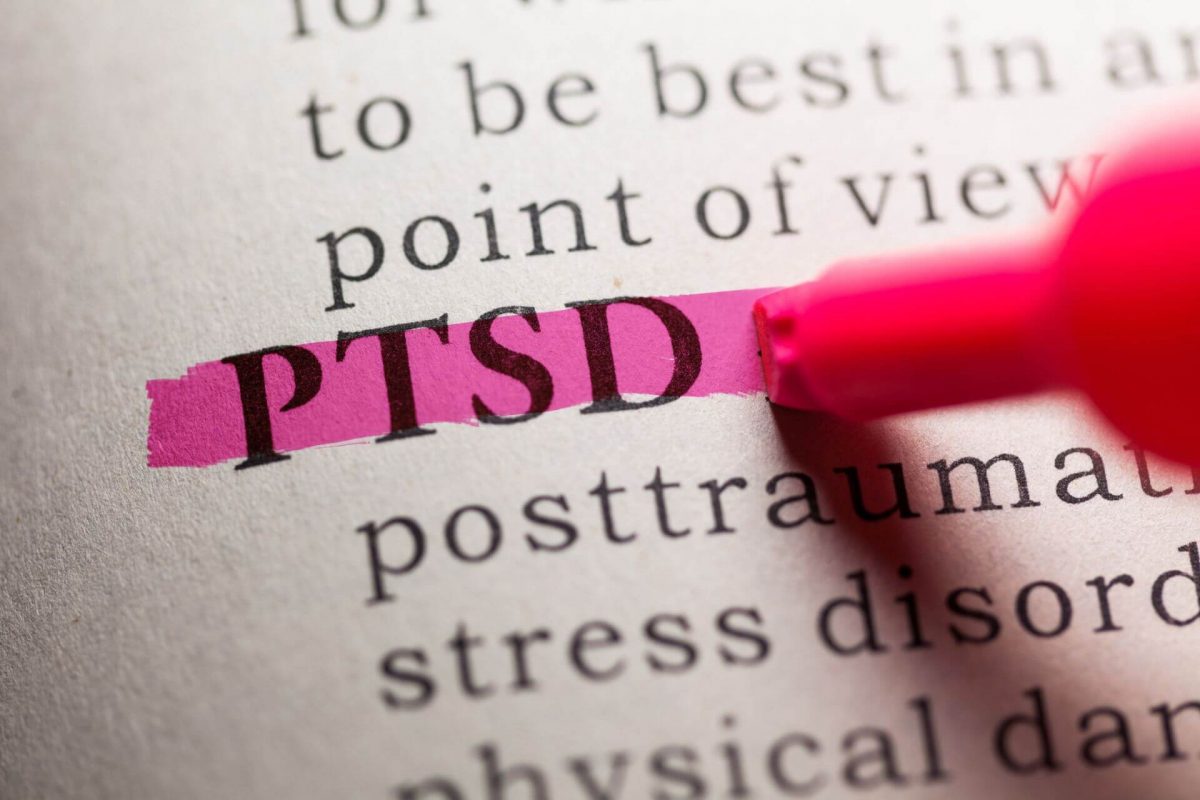People living with post-traumatic stress disorder (PTSD) are at risk of developing substance use disorder – addiction – through attempts to use drugs or alcohol to self-medicate debilitating symptoms. Drugs or alcohol are often consumed to numb feelings of fear, anxiety, stress and hopelessness. Physical tolerance to the substances builds dependency and leads to addiction, which is a chronic, relapsing brain disease.
Studies show that half of the people diagnosed with PTSD meet the criteria for substance use disorder. PTSD treatment plans should always factor in dual diagnosis because people with the condition are likely to have comorbidities such as substance use disorder, generalised depression, anxiety disorder, panic disorder, obsessive-compulsive disorder, agoraphobia, somatisation disorder and social phobia.
What is PTSD?
Post-traumatic stress disorder (PTSD) is a mental health disorder that affects individuals struggling to recover from experiencing or witnessing a terrifying event, abuse or violent act. The condition can last for months or years, and certain stimuli trigger intense physical and emotional reactions.
PTSD used to be referred to as ‘shell shock’ and was associated with soldiers returning from war or military combat. The DSM-5 diagnosis criteria for PTSD has since been extended to trauma-inducing stressors such as exposure to actual or threatened violent acts, sexual violence, abandonment, neglect, serious physical injury or death.
How does PTSD develop?

A large majority of the world’s population experiences a traumatic situation or event in their lifetime, but less than 10 percent develop PTSD. A critical factor in the evolution of PTSD is the person’s perception of helplessness in the face of trauma or reminders of past trauma.
This sense of helplessness keeps sufferers in a cycle of hyperarousal which later develops into a mental disorder with permanent changes in brain structure and function.
PTSD can develop after experiencing or witnessing:
- acts of terrorism
- death or injury in military combat
- serious injury from an accident
- emotional neglect, rejection or abandonment
- death of a loved one
- natural disasters
- domestic, gender-based violence
- sexual abuse or attack, molestation
How does trauma change brain chemistry?
PTSD develops because the natural alarm system in your brain becomes overly-sensitive, doesn’t shut down and is easily triggered. Other parts of your brain that control thinking, emotions, and memory stop functioning correctly. This abnormal brain functioning makes it difficult for someone who has PTSD to distinguish between safe and dangerous events.
Neuroimaging has allowed scientists to study biological changes in brain chemistry that affect how a person with PTSD functions daily. Not everybody experiences the same PTSD symptoms or brain changes, but discernable patterns can be identified and treated.
Let’s look at the formula for PTSD and how the condition develops.
Overactive amygdala
PTSD is linked to your amygdala, the central zone in the neural system responsible for processing threatening and frightening stimuli. The amygdala sets off your natural alarm system in response to dangerous, violent or threatening events, triggering a fight-or-flight response.
People with PTSD have an overactive response to their natural alarm system, meaning something as harmless as a door slamming or a car backfiring can instantly trigger anxiety and panic. People with PTSD struggle to reason when their amygdala is constantly in overdrive.
Underactive prefrontal cortex
Another part of the brain that is out of sync is your prefrontal cortex. It stops functionally properly, affecting normal emotional responses to everyday stimuli.
The prefrontal cortex is found in the front of your brain and regulates emotions, thinking and decision-making. It’s described as the ‘braking system’ in your brain because it slows down or puts the brakes on intense emotional reactions.
Overactive amygdala plus underactive prefrontal cortex
PTSD symptoms are caused by a combination of an overactive amygdala and underactive prefrontal cortex. It is likened to riding on a speeding train with no brakes, leaving the person terrified and extremely anxious in a fight-or-flight response.
Plus, an overactive hippocampus
The hippocampus lies buried deep in your brain and is your memory centre. It stores memories the same way a computer hard drive stores data. People living with PTSD have a hippocampus that works overtime, constantly recalling a traumatic event and trying to make sense of it.
The problem is the information generated by the hippocampus is not coded correctly because of how terrifying an event was, leaving the person struggling to remember important details and separating what is real from what is not.
The result
When your amygdala, prefrontal cortex and hippocampus are not working correctly, your brain will struggle to regulate fear, thinking, decision-making and memory. Trauma can lead to permanent brain changes, and there is no straightforward cure for PTSD. It is a treatable condition that may last for months or years, and medication and psychotherapy help people with PTSD cope with incapacitating symptoms.
Why PTSD and substance use disorder often go hand-in-hand?

PTSD with a co-occurring substance use disorder is known as dual diagnosis. One of two scenarios lead to this condition: someone with PTSD self-medicates with drugs or alcohol, or someone with a chronic drug or alcohol addiction develops PTSD.
Self-medicating PTSD symptoms
People with PTSD use drugs or alcohol to cope with, numb or escape from unbearable symptoms, otherwise known as self-medicating.
Common symptoms of PTSD include:
- flashbacks, nightmares
- insomnia, poor quality sleep
- fear, anxiety, depression
- hyperarousal
- helplessness, hopelessness
- agitation, hostility, irritability
- oversensitive, hypervigilant
- guilt, shame
- isolation, loneliness
- risky behaviour, self-destructive acts
- social phobia, mistrust people
- loss of interest in family, friends and activities
- unwanted thoughts, paranoia, hallucinations
- emotional detachment, disconnected
- suicide attempts
Addiction-induced PTSD
Addiction takes people on a harrowing journey that often involves risky behaviour, emotional or physical abuse and sometimes violence to satisfy cravings. In recovery, you may experience those memories as flashbacks or nightmares, which triggers distressing symptoms like anxiety, depression, agitation, breathlessness and insomnia.
These symptoms can develop into mental illnesses such as anxiety disorder, panic disorder and social phobia. In this case, dual diagnosis is present and treated with an integrated treatment plan at an inpatient or outpatient facility.
How is PTSD treated?
There is no straightforward cure for PTSD, but it is a treatable condition. Medication and psychotherapy help minimise or eliminate symptoms, allowing people to function daily and live a fearless, fulfilling life.
It’s essential to treat PTSD and co-occurring substance use disorder at the same time. Both mental health disorders lead to permanent biological changes that affect brain structure and function. Advanced psychotherapy techniques can help undo some damage and give you tools to cope with upsetting symptoms.
Medications for PTSD
Medication used to treat generalised depression, anxiety, and panic disorders effectively treat PTSD with co-occurring substance use disorder.
- selective serotonin reuptake inhibitors (SSRIs)
- serotonin-norepinephrine reuptake inhibitors (SNRIs)
- antipsychotics
- anti-hypertensive alpha-blocker prazosins
Psychotherapy for PTSD
Several psychotherapy techniques are used to treat co-occurring PTSD and substance use disorder, including cognitive behavioural therapy (CBT), dialectal behaviour therapy (DBT) and interpersonal therapy. These talk therapy techniques help you alter your emotional response to triggers, change behaviour patterns, and regulate negative thoughts and feelings.
Psychotherapy treatment explicitly designed to treat PTSD includes:
Eye movement desensitisation and reprocessing (EMDR)
Eye movement desensitisation and reprocessing (EMDR) is one of the most popular psychotherapy techniques for PTSD treatment. It is designed to help sufferers recover from debilitating symptoms and emotional stress caused by traumatic events.
EMDR works on the basis that your brain’s neural system can heal from psychological trauma in the same way your body recovers from physical injury. The therapy unblocks your brain’s information processing system to allow natural healing to resume.
Patients are reconnected to personal thoughts, emotions, feelings, and images connected to past trauma in a safe and supportive way. Over eight treatment phases, traumatic memories and stimuli should no longer provoke distressing reactions and negative thoughts.
Trauma-focused cognitive behavioural therapy (T-F CBT)
This form of CBT focuses on how you perceive a traumatic event and cope with the mental and emotional anguish. The trauma-based technique was developed specifically to treat patients between 13 and 18 years with PTSD and mood disorders brought on by emotional or sexual abuse, abandonment, grief and violence.
A CBT therapist helps you process past traumatic experiences and push through moments that cause distress and where you get stuck. The aim is to alter negative or distorted beliefs, thinking, reactions and behaviour, provide a safe environment for patients to talk about how they feel when exposed to different stimuli, and learn coping skills to deal with everyday life stressors.
Psychodynamic therapy
Psychodynamic therapy focuses on the unconscious mind, including unexplained urges, unwanted thoughts, distressing feelings, and unconscious denial and displacement. Unconscious negative thoughts and feelings make you behave in a certain way that can cause psychological pain and physical discomfort.
This psychotherapy technique requires you to recognise and work through unconscious feelings, no matter how painful and distressing. The aim is to break down your defense mechanisms and replace negative automatic thoughts with positive affirmations, feelings and behaviour.
Virtual reality exposure therapy (VRET)
VRET is a new form of therapy for PTSD and has proven to reduce fear and desensitise sufferers to the impact of past trauma. VRET uses technology to expose you to trauma stimuli gradually, and memories of past experiences cause you to feel fearful and highly anxious. You work with a specialised therapist in a safe, secure environment to overcome these feelings.
VRET is like playing 3-D games on your computer, but the simulated situations mimic your PTSD triggers. The technique is used extensively to treat soldiers returning from military combat, using a simple PC, keyboard and virtual reality headset. VRET is also used to help children on the autism spectrum develop social skills, and stroke patients improve muscle coordination and control.

We’re here to help.
Contact us today if you’d like a confidential and free chat with one of our qualified mental health and addiction care professionals at White River Manor in South Africa.







